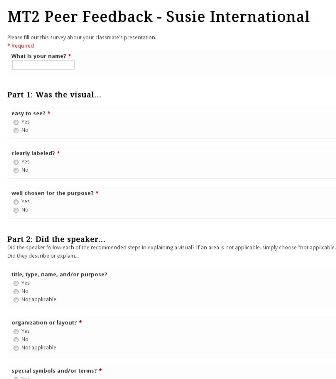|

Lennox Archer |
|

Krista Royal |
It is common practice in ITA classes to utilize
microteaching presentations and for students to give peer feedback of
such presentations. In the University of South Florida’s Spoken English
for ITAs course, students complete about six microteaching presentations
during the semester. For each of these presentations, other students in
the class complete peer feedback forms, which include what they were
able to learn from the presentation, the perceived strengths, and
suggested areas for improvement. This feedback is useful for a variety
of reasons. First of all, it keeps all audience members engaged in the
presentations. Students learn from each others’ successful strategies as
well as from others’ mistakes, and presenters get feedback from
multiple sources. Patterns and trends emerge from the data that can help
identify which areas need the most attention.
For the first several iterations of the ITA class, we used a
paper-based system for peer feedback. With this method, the instructor
would prepare copies of the peer feedback form for each student. (Note
that in a class of 15, with each person providing feedback on the other
14 people, that was over 200 forms per assignment!) Even printed on a
half sheet, it meant a lot of paper was being used. All that paper had
to be processed, too, which took time. During the class, students
completed the forms for each presenter. After the presentations were
complete, the instructor reviewed each form and prepared the forms for
distribution.
To protect anonymity and promote candid feedback, the rater
names were removed before the forms were scanned and e-mailed to
students as an attachment. Additionally, sometimes there were students
in the class with very identifiable or illegible handwriting, or with
significant spelling or grammar issues that impeded comprehensibility.
In these situations, both to help the recipients better understand the
comments and to protect the scribe, the comments would be typed by the
instructor. While this helped the instructor synthesize the information,
it did take a significant amount of time. It was an imperfect system,
but we felt the exercise was valuable, and that students appreciated the
feedback and used it to inform their self-reflections. Despite the
shortcomings of the system, we didn’t want to eliminate the forms, but
hadn’t yet considered doing them another way.
A few semesters ago, Lennox taught the ITA class for the first time,
and brought a fresh perspective, He discovered that the same goals could
be accomplished in a more streamlined manner using Google Forms. Google
Forms, which are easy to create and complete, enabled getting the
feedback to the students in a timely manner without the labor that was
previously involved.
By using Google Forms, we noticed several advantages for
peer feedback. One such advantage is the ease of use for both the course
instructor and the rater. The platform is very user-friendly, and it is
constantly being improved upon. For the raters, the forms can be filled
out easily using devices they already have on hand. Because there is no
need to print multiple copies of peer feedback forms, this method saves
paper. Logistically, there is an advantage as well in that the forms
can be shared with students electronically before class, so there is no
time lost in distributing handouts, and students can familiarize
themselves with the form before completing it.

Image 1. Sample form (click on image to enlarge).
Without the paper form, users also have the advantage of communicating
in a format that is familiar to them and that they may find advantageous
for use with their students later. Part of our goal is not just
teaching language skills for teaching but also providing ITAs
familiarity with tools and methods they can use in their own classrooms.
Google Forms can be useful for many contexts, and when working with
undergraduate classes in the United States, ITAs are likely to encounter
audiences who are comfortable with, and often prefer, communicating
with online tools. The advantage for the ITA (and for the ITA course
instructor) is the reduction of handwriting and spelling variables in
the responses. Students who write comments can do so with anonymity and
with the aid of a spell-check tool.
To use Google Forms for peer feedback, you will need a Google account,
which is free. From Gmail, click on “Drive” and then “Create,” then
“Form.” For detailed instructions on creating a form, please see this
Google help article. Although it takes slightly longer to set
up, creating unique forms for each student means that Google will
compile the results separately and you can more easily separate
responses. After laying out the original feedback form, we create a
unique form for each student doing a microteaching presentation, by
simply choosing “File” then “Make a Copy” and editing the presenter name
on the new form. Once the forms are created, they can be shared with
students electronically within Drive or by sending the links. Students
can answer the questions for each peer teaching assignment while they
watch or after they watch. As the instructor, you can verify that each
student did their part by checking the respondent name column in a
response spreadsheet (see Image 2). You can also delete the column that
identifies the student giving feedback when sending the summary of
responses. 
Image 2. Sample responses (click on image to enlarge).
As a teaching aid, there are some tips to keep in mind when
implementing Google Forms for peer feedback. Students may access Google
Forms easily from electronic devices, and can answer questions directly
from e-mail, but this means that students will need network coverage or
Wi-Fi access in the classroom. There is also a potential element of
distraction using Google Forms, but this does not seem to greatly exceed
the distraction of the paper form. If there are students who prefer to
take notes on paper, they can easily print the form and bring it to
class and then transfer their notes later. The same is true for students
who do not own portable electronic devices.
Using Google Forms for peer feedback saves resources and better
utilizes the students’ electronic devices that are already present in
class. Sending the feedback to students is faster and more efficient
than paper-based methods. It has been a successful change for us, and we
encourage you to try it too!
Lennox and Krista are both faculty members at USF’s English
Language Program. Both have MAs in Applied Linguistics/TESL from USF.
They have taught and coordinated a variety of ESL courses, including the
Spoken English for ITAs class. |

